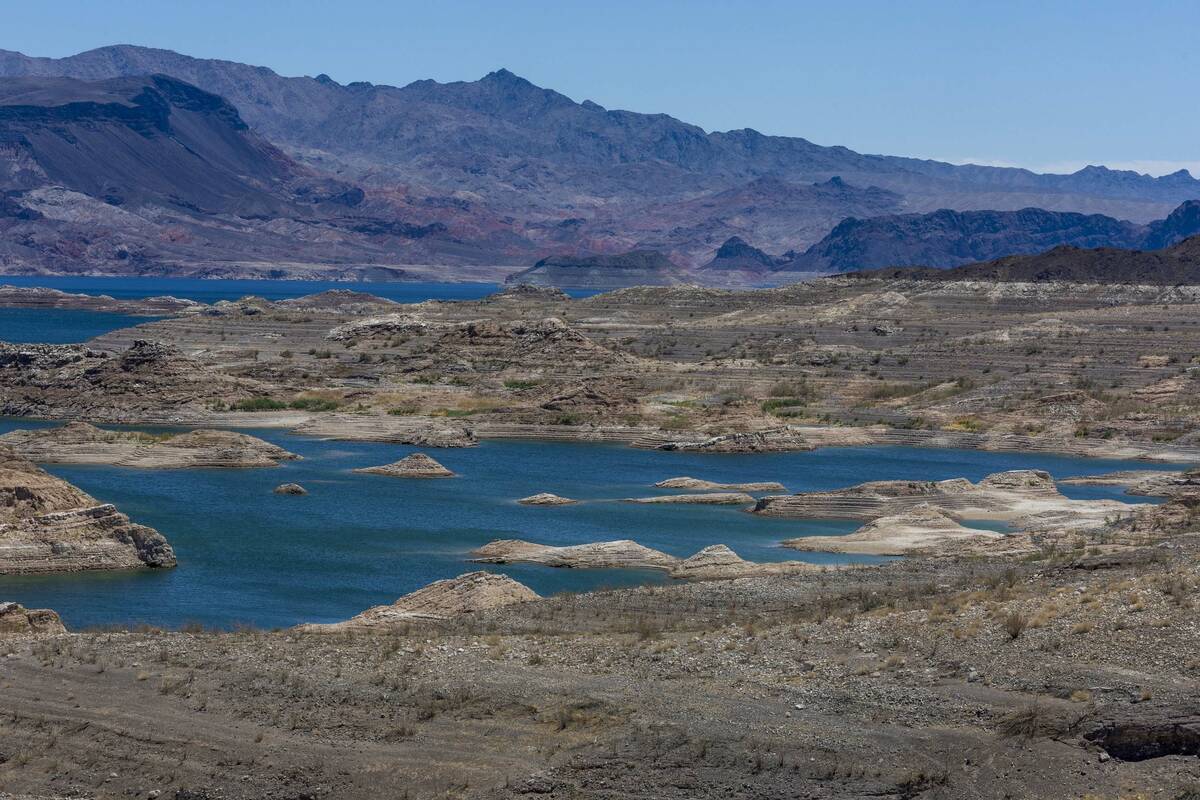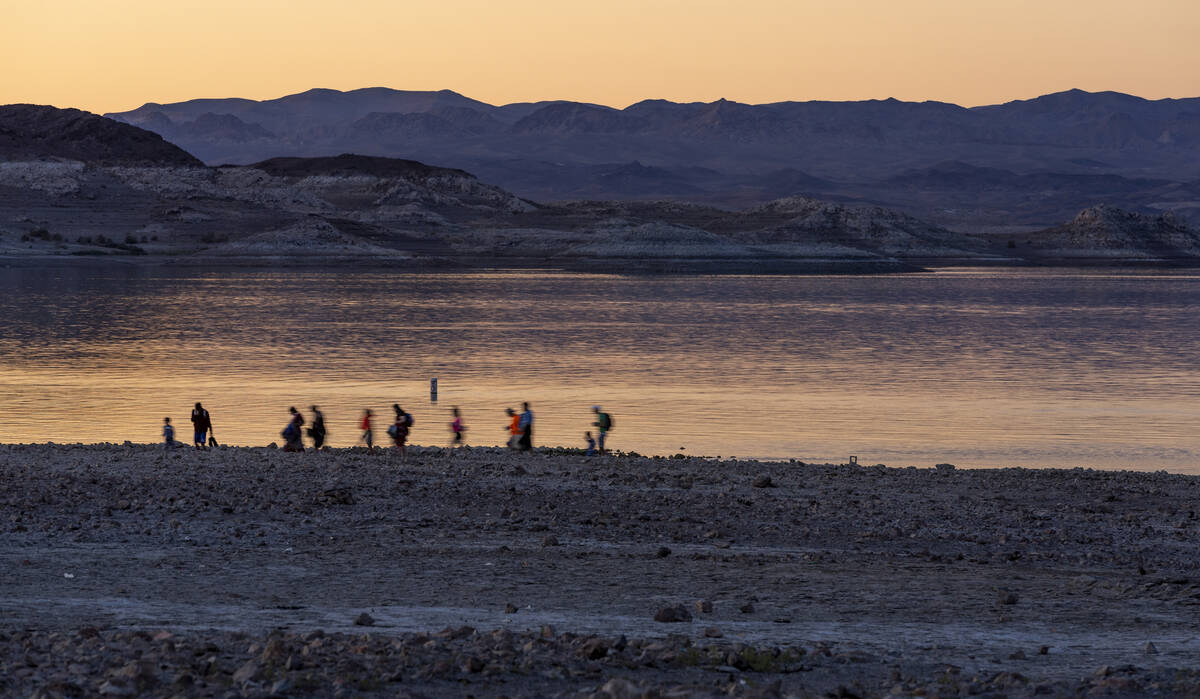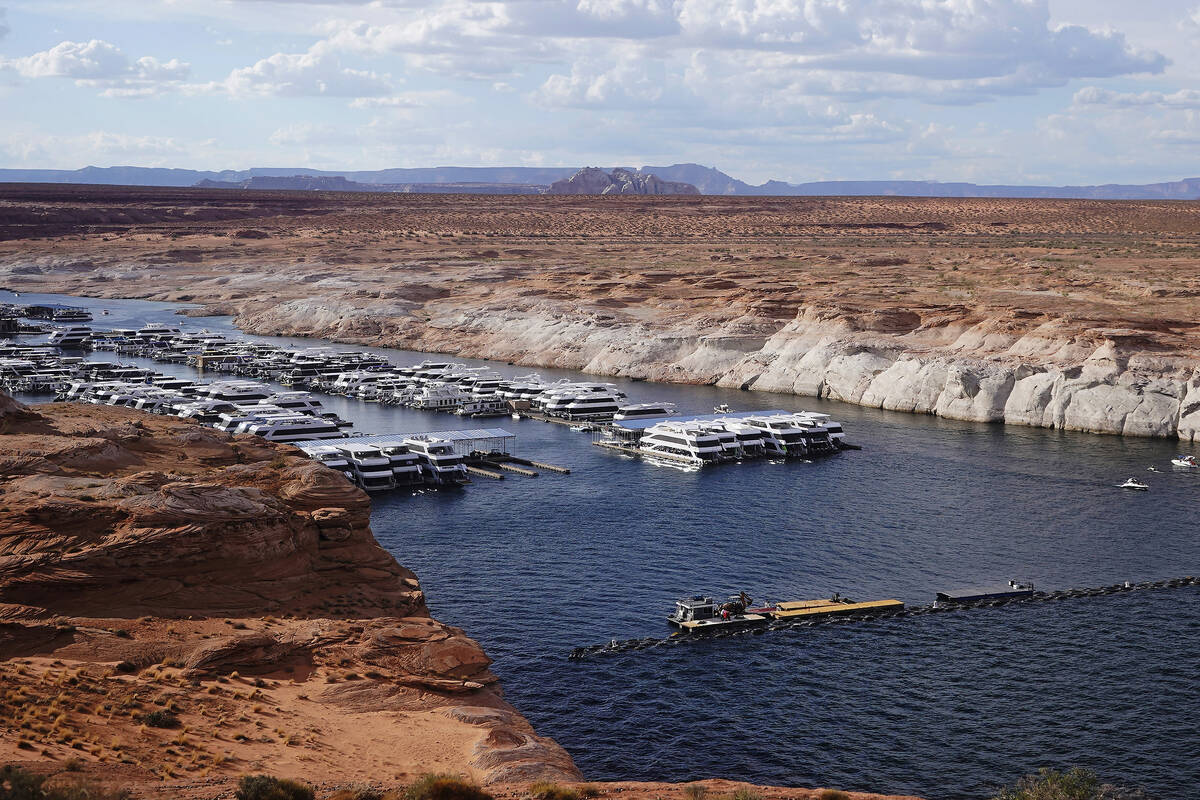Nevada works with California, Arizona to propose drastic water cuts
Nevada and two of its neighboring southwestern states are still working on ways to drastically cut water use from the Colorado River as a deadline set by the federal government to address the worsening conditions along the river quickly approaches.
John Entsminger, general manager of the Southern Nevada Water Authority, said his organization is still at the table with the other so-called lower basin states of California and Arizona as they work to respond to a call from the U.S. Bureau of Reclamation to propose unprecedented cuts in water use along the river in order to protect critical power and water delivery infrastructure at lakes Mead and Powell.
Bureau of Reclamation Commissioner Camille Touton gave the states until mid-August to submit plans to reduce usage in 2023 by 2 million to 4 million acre-feet of water, the high end being equal to about one-third of the Colorado’s recent annual flow. Touton warned in a Senate hearing in June that if the states do not come up with plans, the agency has the authority to “act unilaterally to protect the system, and we will protect the system.”
The upper basin states — Wyoming, Colorado, Utah and New Mexico — together submitted a plan to the agency in a letter dated July 18. But with little more than two weeks left until the bureau’s Aug. 15 deadline, the lower basin states have yet to put forward any proposals publicly.
“We’re still hopeful for a multistate solution,” Entsminger said in an interview last week. But Southern Nevada’s water boss said the authority is prepared to submit a proposal on its own, if need be.
No cuts in Nevada
Entsminger said he doesn’t think Southern Nevada would need to cut any more water use even in the face of reclamation’s call, noting that the region consumes about 20 percent less than its legal allocation of 300,000 acre-feet of water from the river that supplies roughly 90 percent of Southern Nevada’s water. Any cuts should come from states’ legal entitlements, not from their current uses, he said.
The upper basin’s proposal, detailed in a letter from the Upper Colorado River Commission to the Bureau of Reclamation dated July 18, lays out a five-point plan on how the upper basin states will look to reduce usage of the river.
But the proposal contains no mandatory reductions in use for the upper basin, further reflecting the political divisions along the river among the lower basin states of Nevada, Arizona and California, where most of the Colorado’s water is consumed, and the four upper basin states that have historically stayed below their legal allocations.
While he acknowledged the lack of mandated reductions, Entsminger said the upper basin’s proposal provides “a solid framework.”
“It really is enumerating the tools that are available to the upper basin to manage their demands in the face of this diverging process,” Entsminger said. “Given that the lower basin has not put anything substantive on the table yet, I don’t blame them for not publicly negotiating against themselves.”
The upper basin states said in the letter they recognize that preserving levels at the two main storage reservoirs will take collaboration among the seven basin states, but the tools water managers have in the upper basin are “limited.” The plan includes commitments to pursue programs that are currently up for consideration, such as paying ranchers and farmers to use less water.
They argued that since depletions in the lower basin and Mexico are more than double the upper basin, cuts should be focused downstream of Lake Powell.
Upper basin versus lower
John Fleck, a water researcher at the Utton Center at University of New Mexico School of Law, said that without any required cuts in the states’ proposal, it isn’t clear if the upper basin is willing to actually contribute to addressing the problem that is affecting states across the entire basin.
The upper basin states are correct that they use substantially less water than their southwestern counterparts, Fleck said, and simply looking at the math in the basin shows that the brunt of the cuts that are coming are going to fall on Arizona and California because that is where most of the water is used.
But he said that for the sake of equity and fairness, all of the states need to recognize that the cuts and the worsening conditions along the river amid the two-decadeslong drought is a problem shared across the entire basin.
“The way climate change is reducing the size of the river, everyone has to use less water, period,” Fleck said.
Whether the states can come to an agreement on cuts that satisfy all sides is to be determined. But Fleck said that won’t really matter, as the cuts are coming one way or another “and it’s just a matter of how gracefully or ugly the process of coming to terms with them is.”
Water scientists’ proposal
While the seven basin states have been crafting plans to cut, a group of water researchers last week released a new study detailing how they think the states should share the load and stabilize water levels at lakes Mead and Powell.
The analysis, detailed in an article in Science published on July 21, suggests the current schedule of tiered cuts is not aggressive enough to deal with the deteriorating conditions of the overtaxed river, and that sticking with the status quo would lead to water levels dropping at the two reservoirs to a point that would threaten their respective dams’ abilities to generate hydropower and send water downstream.
Their approach revolves around using the combined amount of water stored at both reservoirs to trigger cuts to water use in the lower basin, rather than the current system that relies solely on Lake Mead’s level.
That’s an approach that Entsminger says is in line with what the water authority would like to see in the future in terms of managing the river system’s total contents.
“We know we have to reduce existing uses across the basin to get the river into equilibrium. So any new use anywhere in the basin needs to be offset by a commensurate reduction,” Entsminger said.
The analysis puts forward a significantly more aggressive plan that calls for steep cuts for the water-strapped lower basin states. Meanwhile, the less-developed upper basin states would then limit their uses from the river to near current levels, which would force them to limit plans for new developments and water diversions.
Under the plan, the upper basin states would need to cap new water use to 4.5 million acre-feet per year, which is higher than the 3.7 million acre-feet annual average the basin used from 2000 to 2020. To balance things out, the lower basin states would need to cut their use by 3 million acre-feet.
If the upper basin caps its use to just 4 million acre-feet, the cuts needed in the lower basin would be roughly 2 million acre-feet.
“Our results show that although current policies are inadequate to stabilize the Colorado River if the Millennium Drought continues, various consumptive use strategies can stabilize the system,” the authors wrote. “However, these measures must be applied swiftly. Although these concessions by both basins may seem unthinkable at present, they will be necessary if recent conditions persist.”
Contact Colton Lochhead at clochhead@reviewjournal.com. Follow @ColtonLochhead on Twitter.

























